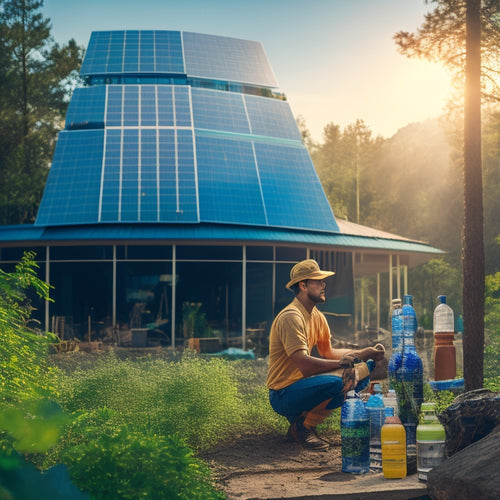
Tiny House Greywater Systems: Maximizing Water Efficiency
Share
You can design a greywater system that reduces your water bills by up to 30% and helps protect the environment, making it an essential component of sustainable tiny house living. By understanding the different sources of greywater, such as sink water, shower runoff, and laundry discharge, you can maximize water efficiency. A well-designed system can last for decades, minimize chemicals and pollutants, and support your eco-friendly lifestyle. To get started, prioritize your greywater sources, select the right components, and implement sustainable practices - and as you investigate the complexities of greywater systems, you'll uncover even more ways to optimize your water efficiency and minimize your environmental footprint.
Key Takeaways
- Greywater systems can reduce water bills by up to 30% and support sustainable lifestyle choices in tiny house living.
- Effective system design involves identifying and prioritizing greywater sources, selecting appropriate components, and implementing sustainable practices.
- A well-maintained greywater system requires regular monitoring of flow to prevent clogs and backups, and regular cleaning of filters.
- Compliance with local regulations and obtaining necessary permits is critical for greywater systems to avoid penalties and ensure ecological standards.
- Proper filtration and treatment are essential for safety, as improper greywater use can pose health risks, including disease transmission from contaminated greywater.
Understanding Greywater Basics
Frequently, homeowners and tiny house dwellers alike are drawn to greywater systems as a means of conserving water and reducing their environmental footprint.
You're likely considering greywater recycling for your tiny house, but first, it's crucial to understand the basics. Implementing sustainable practices like greywater recycling can also reduce your reliance on traditional power sources and lower operational costs, much like commercial solar charging systems.
Greywater refers to wastewater generated from sinks, showers, and washing machines - fundamentally, all non-toilet water. This water can be reused for irrigation, toilet flushing, and even washing machines, reducing your water consumption and reliance on municipal supplies.
Benefits of Greywater Systems
As you consider implementing a greywater system in your tiny house, you're likely wondering what benefits you can expect from this sustainable practice. By utilizing greywater, you'll considerably reduce your environmental impact by decreasing the amount of wastewater that enters sewage systems and conserving potable water for irrigation and flushing toilets.
Additionally, optimizing energy efficiency in your tiny house through renewable energy solutions can further improve your eco-friendly lifestyle. Furthermore, evaluating energy storage needs and investing in grid resilience measures can guarantee a stable power supply for your sustainable systems.
Here are three key benefits to expect:
-
Cost savings: Greywater systems can reduce your water bill by up to 30%, especially in areas with high water costs.
-
Health considerations: By reusing greywater, you'll minimize the amount of chemicals and pollutants that enter the environment, creating a healthier ecosystem.
-
Increased system longevity: Properly installed and maintained greywater systems can last for decades, providing a long-term solution for water conservation.
With these benefits, you'll not only reduce your environmental footprint but also enjoy cost savings, improved health considerations, and a more sustainable lifestyle in your tiny house.
Tiny House Greywater Challenges
Implementing a greywater system in your tiny house can be a complex process, and you'll likely encounter some challenges along the way. One major concern is greywater contamination, which can occur if your system isn't properly designed or maintained.
You'll need to guarantee your system's aesthetics blend in with your tiny house's design, while also minimizing its environmental impact. Additionally, incorporating renewable energy sources, such as solar-powered fast charging, can help reduce your carbon footprint.
User education is essential to guarantee you understand how to operate and maintain the system. Maintenance challenges, such as clogged pipes and odor control, will require your attention.
Additionally, plumbing integration and environmental compatibility must be considered to avoid costly mistakes. By being aware of these potential challenges, you can better prepare yourself for a successful greywater system installation.
Designing an Effective System
When designing an effective greywater system for your tiny house, you'll need to identify and prioritize your grey water sources, such as sinks, showers, and washing machines.
Implementing sustainable practices, such as fuel efficiency tracking, can also help reduce your environmental impact.
Next, you'll select the right components, including tanks, filters, and pumps, to handle the volume and type of water you're working with.
Grey Water Sources Defined
Your tiny house's greywater system relies on identifying and employing the right grey water sources to function effectively. Grey water is generated from various household activities, and it's crucial to identify these sources to design an efficient system.
Incorporating alternative fuel solutions, such as biodiesel renewable energy solutions, can also contribute to a more sustainable tiny house. Additionally, considering hybrid electric solutions can improve fuel efficiency and reduce emissions.
-
Sink water: Water from sinks, including kitchen and bathroom sinks, is a significant grey water source.
-
Shower runoff and laundry discharge: These sources generate a substantial amount of grey water, perfect for irrigation and flushing toilets.
-
Kitchen waste: Although kitchen waste contains more contaminants than other sources, it can still be employed for outdoor irrigation after proper treatment.
System Component Selection
You've identified the grey water sources in your tiny house, now it's time to design an effective system by selecting the right components. This is a vital step in maximizing water efficiency and minimizing your environmental footprint.
| Component | Considerations |
|---|---|
| Pump Selection | Choose a pump that can handle the flow rate and pressure needed for your irrigation system. Look for eco-friendly materials and energy efficiency. |
| Filtration Options | Select a filter that can remove contaminants and sediment from your grey water. Consider a system with multiple stages of filtration for best results. |
| Storage Solutions | Determine the storage capacity needed for your system, considering factors like water usage and irrigation schedules. Confirm your storage tank is made from eco-friendly materials. |
| Treatment Methods | Decide on a treatment method that suits your needs, such as aerobic or anaerobic treatment. Consider integrating composting toilets for added efficiency. |
Water Flow Management
Two key principles guide the design of an effective greywater system: maximizing water flow and minimizing backup risks.
You want to guarantee that greywater flows efficiently through your system, reducing the likelihood of clogs and backups. To achieve this, you'll need to take into account the following:
-
Flow rate management: Calculate your greywater generation rate and design your system to handle peak flows, guaranteeing that your pipes and components can handle the volume.
-
Pressure management: Install pressure-relief valves and air admittance valves to prevent backpressure buildup and guarantee smooth drainage.
-
Drainage solutions: Incorporate filtration options, such as sedimentation tanks or filters, to remove contaminants and debris, and take into account irrigation techniques that reuse greywater efficiently.
Installation and Maintenance Tips
Every tiny house owner who decides to incorporate a greywater system must consider several vital installation and maintenance tips to guarantee the system functions efficiently and safely.
When installing your greywater system, it's essential to use proper installation techniques, such as sloping pipes to assure gravity-fed flow and avoiding sharp bends that can cause clogs.
You should also create a maintenance schedule to regularly inspect and clean your system. This includes checking for leaks, cleaning filters, and monitoring water flow.
Greywater Regulations and Compliance
One of the most critical considerations when it comes to greywater systems in tiny houses is compliance with local regulations.
You'll need to research and understand the specific greywater regulations in your area to avoid compliance challenges.
Here are three key factors to contemplate:
-
Local codes and permit requirements: Make sure you obtain necessary permits and comply with local building codes.
-
System approvals and ecological standards: Your system must meet ecological standards, and you may need approvals from local authorities.
-
Health considerations and legal implications: Failure to comply can result in legal implications and health risks, so it's vital to prioritize these aspects.
Frequently Asked Questions
Can I Use Greywater for Flushing Toilets and Running Washing Machines?
You can definitely use greywater for flushing toilets and running washing machines, but first, you'll need to implement effective filtration methods to reap the greywater benefits, ensuring a safe and efficient system that saves you water and money.
How Long Does a Typical Greywater System Last Before Needing Replacement?
You've seen the success of greywater systems, like the one in Oregon's Tryon Creek State Park, which lasted 10 years with regular maintenance. Typically, a well-maintained system can last 8-12 years, but you'll need to replace components every 5-7 years, following maintenance tips like regular cleaning and filter checks.
Are Greywater Systems Suitable for Houses With Septic Systems?
You'll find that greywater systems are indeed suitable for houses with septic systems, as they reduce water flowing into the septic tank, allowing it to function more efficiently, and you'll reap greywater benefits like increased water efficiency and a healthier septic integration.
Can I Connect My Greywater System to a Municipal Sewer Line?
You're swimming in uncharted waters, wondering if you can hook your greywater system to the municipal sewer line. Unfortunately, it's not a straightforward answer - you'll need to explore local greywater regulations before system installation to guarantee a smooth sail.
Do Greywater Systems Require Special Types of Soap and Cleaning Products?
You'll want to choose soap and cleaning products with gentle, biodegradable ingredients that won't harm the environment or clog your system; opt for eco-friendly cleaning alternatives and read labels carefully to ascertain they're safe for greywater reuse.
Related Posts
-

What Tax Deductions Apply to Sustainable Building Materials?
You can claim various tax deductions for sustainable building materials, thanks to over 40 federal tax incentives sup...
-

What Cool Roof Tax Breaks Can Homeowners Claim?
You can claim federal tax credits of up to $500 and state and local incentives for installing cool roofs, which not o...
-

3 Eco-Friendly Automated Blinds for Contemporary Living
You're looking to raise your living space with automated blinds that not only exude contemporary style but also align...


